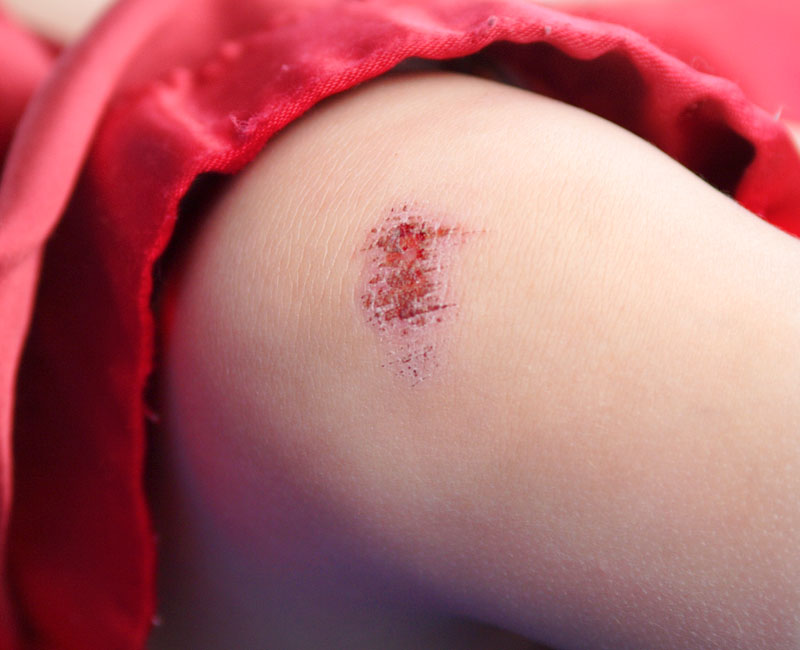Road rash happens when your skin rubs against a paved surface. It generates heat that burns you and the force of the friction can further damage exposed skin and tissues underneath. Minor road rash is something you can treat on your own. But sometimes, it needs professional medical care to prevent complications like infections and scarring.
Advertisement
Cleveland Clinic is a non-profit academic medical center. Advertising on our site helps support our mission. We do not endorse non-Cleveland Clinic products or services. Policy

Road rash is a specific type of friction burn you can get from paved surfaces. It can happen when asphalt, cement or concrete rubs against your skin hard enough to physically damage it and generate heat. Road rash can be a severe issue when the burn is deeper, especially if it also covers a larger amount of your body’s surface area.
Advertisement
Cleveland Clinic is a non-profit academic medical center. Advertising on our site helps support our mission. We do not endorse non-Cleveland Clinic products or services. Policy
Like all burns, experts classify road rash severity based on how deep the burn goes. The severity levels are:
In very severe cases, road rash can extend beyond the fat layer underneath your skin, damaging tissues like muscle and bone underneath.
Road rash can cause the following symptoms:
Advertisement
You can get road rash if you fall onto a paved surface while doing any of the following:
When you fall during one of these activities, you hit the pavement, but you don’t stop immediately. Instead, your momentum drags you along the paved surface, creating friction.
Road rash can be particularly severe because it takes a lot of physical force for you to slide on a paved surface. And the longer the distance you slide on the paved surface or the faster you move doing so, the worse the burn will be.
When severe, road rash can cause many complications. They include:
Like flame or scalding burns, severe road rash can put a strain on your body systems. Large partial-thickness and full-thickness burns can cause life-threatening complications like:
A healthcare provider can diagnose road rash by looking at the injury and learning more about how it happened. In many cases, people with road rash aren’t conscious because of their injuries. Providers instead will rely on official reports from first responders or loved ones who saw you get hurt.
Lab and imaging tests are also likely if you have road rash. That’s because they can help diagnose or rule out related injuries or complications. Blood or urine tests may help detect toxic effects from the burn before they can affect your internal organs. And imaging scans like X-rays or computed tomography (CT) scans can detect bone fractures or internal injuries.
Like with all burns, the treatment for road rash depends strongly on a few factors:
Advertisement
Superficial road rash burns need minimal or no treatment. You can treat these yourself at home.
You may also be able to self-treat partial-thickness road rash burns if they’re small enough. A good guideline is whether you can cover them with your hand. If they’re larger than your hand, they need professional care. And full-thickness burns always require expert medical attention. The care they need can include:
Advertisement
Your healthcare provider is the best source of information about your specific case. They can provide information and guidance that are specific to your case.
The shallower the road rash burn, the less time your recovery should take. Superficial burns should heal within a couple of days. Deeper burns can take weeks or more. Other factors can also influence what you can expect and how long it takes you to recover. Your healthcare provider is the best source of information about what you can and should expect after getting road rash. They can also guide you on what to do to help make your recovery as easy and fast as possible.
The outlook for road rash depends mainly on how deep and large the burn is. But road rash commonly happens along with other injuries like broken bones, lacerations and more. Those other injuries may heavily influence the outlook for your case. Your healthcare provider can tell you more about the outlook for your case and what’s affecting it.
There are several things you can do to prevent road rash or at least lower your risk of getting it. They include:
Advertisement
If you have road rash, it’s important to handle it the right way. Superficial burns are a lot like scrapes and you can self-treat them at home.
But if your burn is — or you think it could be — more severe, you shouldn’t hesitate to get medical attention. Call your healthcare provider or get medical care if:
You need emergency medical attention if you have a road rash friction burn that might be partial thickness or deeper and the burn is:
Some questions you can ask your healthcare provider include:
It’s common to look forward to the feel of the open road, but feeling the road against your skin can put a damper on your plans. Road rash is often painful and can interfere with activities that you need or would prefer to be doing. Fortunately, road rash is very treatable, and you can take care of these burns yourself when they’re shallower and smaller. It’s also an injury you can often prevent.
If you have road rash and want to know if you can make your recovery faster and smoother, talk to a healthcare provider. Timely care can make a big difference with road rash burns. That could be just what you need to get you back on the road sooner rather than later.
Need care fast? Cleveland Clinic’s Express Care and Urgent Care locations treat everything from sprains to sinus infections — no appointment needed.

Last reviewed on 02/26/2025.
Learn more about the Health Library and our editorial process.